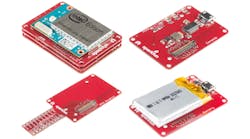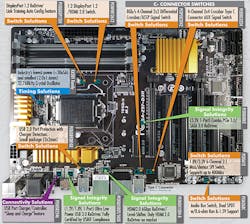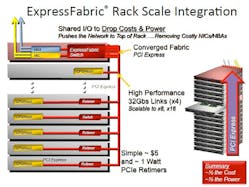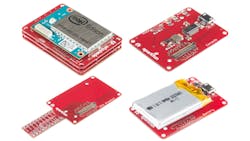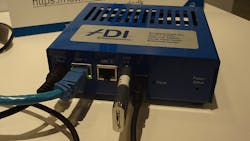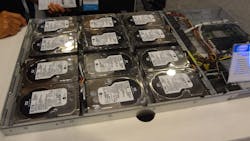Intel Developers Forum news tends to vary from year to year. Sometimes Intel makes a big splash with their technology and other times it is more about their partners. I think this year is the latter. Intel did have some new things to harp about like the tiny Edison module (see “Edison Lights Up IDF 2014”) and its usual collection of processors from mobile to through to the enterprise but I found more interesting things on the floor dealing with technologies like SDN (software defined networking) and NFV (network functions virtualization). There was also some interesting things relating to PCI Express, USB 3.x Type C connectors (see “USB 3.1 Type C Connector Is Reversible”). Finally DDR4 was out in force which was not surprising although the performance and capacity was a pleasant addition.
USB and Connector C
The USB 3.1 Type C connector (see “USB 3.1 Type C Connector Is Reversible”) was getting a lot of traction at IDF. As a USB connector, it is quite handy. It is reversible and handles the latest high speed connection. It will likely be the defacto connector on tablets and smartphones in the near future.
Handling the faster data rates and the new higher power charging (see “What’s The Difference Between USB 2.0 And 3.0 Hubs?”) are great but that is not the only thing this connector is used for. As it turns out, the commonality between high speed SERDES is allowing this little connector to handle a range of interfaces and protocols. In particular, PCI Express is one of the protocols is supported using the “alternate mode” of operation. Essentially a system can determine what type of interface is as the other end of the cable and handle is appropriately. DisplayPort is another and there could be more in the future like HDMI.
PCI Express
The “alternate mode” does not just connect the cable to two interfaces. Instead, a crossbar switch like that from Pericom is needed. This would be found on the motherboard (Fig. 1). Pericom actually has a few chips that will find a home near a Type C connector including:
- PI3PCIE3242– 4-Channel 2x2 Crossbar Type C Connector USB 3.0, DP 1.2 Switch
- PI3DBS3224 – 4-Channel 2x4 Crossbar Type C Connector AUX Bandwidth Switch
- PI2EQX502T/502E – 1-Port 1.2/1.8Volt USB 3.0 ReDriver/Repeater (lower voltages available)
- PI3EQXDP1201 – 1-Channel DisplayPort1.2 ReDriver/Repeater
- PI3USB9281 – USB Port Detection/protection IC (device side)
- PI5USB2546 – USB Port Charger/Controller IC (host side)
The crossbar switch is needed to link the cable connector to two different interfaces. This allows a standard interface to be used. These are often built into the host processor or support chip. It means that support for a multimode Type C interface just needs the switch, not a special host interface.
I also had a chat with Pericom about retimers and redrivers that are becoming more important as serial interface speeds rise and we are now using speeds and interfaces that require these devices. The PI3EQX862 is an example of the dual mode connections. This chip handles x1 PCI Express 3.0 and SATA 3.0. Its programmable equalization and de-emphasis is optimized for performance over a variety of physical mediums. It does this by reducing inter-symbol interference. It supports a pair of 100 Ω differential CML signals. Each channel is fully independent.
Pericom has chips to support most protocols. For example, the PI3EQXDP1201 is a DisplayPort ReDriver with an integrated AUX listener.
Another interesting PCI Express demo I saw was from PLX Technology, now part of Avago Technologies. Its ExpressFabric was announced last year at IDF but this year the block diagram (Fig. 2) had some hardware behind it. Actually it was below it.
An ExpressFabric system targets the cloud the rack space architecture (RSA). Every processor in these systems has PCI Express interfaces. They may have Ethernet and storage interfaces but these add overhead compared to PCI Express. Also, many interfaces like flash storage are now native to PCI Express like NVMe (see “What's The Difference Between SATA And NVMe?”).
The trick is the PCI Express switch chip in the top-of-rack (ToR) switch. Essentially the configuration looks like the current Ethernet fabric used in most datacenters except that PCI Express replaces Ethernet.
Anyone remember PCI Express Advanced Switching. It was often referred to as just Advanced Switching (AS). AS was ahead of its time and had many of the attributes of ExpressFabric. AS didn’t make it. ExpressFabric just might.
Edison at IDF
At the other end of the spectrum was Intel’s Edison module platform. Edison runs about $50 and it contains a 500 MHz dual core Atom, WiFi, Bluetooth and a 100 MHz Intel Quark microcontroller. There was a lot of buzz about Edison and it was found on everything from robots, UAVs and connected wheelchairs.
Sparkfun is behind the Edison wave. It even has an Edison starter pack (Fig. 3) that includes a console block, battery pack block and GPIO block. These are stacked using the 70-pin header. This provides a mobile platform that can be easily expanded.
The Edison design is well thought out. It includes 1 Gbyte of LPDDR3 and 4 Gbytes of EMMC flash. It has mounting holes allowing it to be used in rugged systems and the stackable architecture allows a system to be expanded. I am hoping to do a hands-on review in the near future.
There were a few Quark-based systems on display. I’ll cover those in another article. Demand is not high yet but they are so new that I doubt anyone really knows about them yet.
Virtual Networking
SDN, NFV, RSA and Software Defined Data Center (SDDC) were actually the most prevalent technology on display at IDF. I have a new article that is addressing these technologies so I won’t dive into the details here.
Some of the more interesting items at IDF included 25G Ethernet that is one channel of 100G Ethernet. Copper is still around but fiber is likely to be the preferred link at these speeds. Intel’s Silicon Photonics was being pushed.
These technologies are for the cloud and enterprise IT but some of the technologies may find their way to the edge. ADI Engineering’s Intel Edge Cloud Kit (Fig. 4) is an interesting example.
The kit has a multicore Intel Atom C2000. It runs Wind River’s OVP Real Time Hypervisor. This allows it to be included as part of an SDN environment running NFV VMs. Of course, the platform can be used as a powerful gateway without taking on these other technologies.
ADI Engineering is quite familiar with SDN providing whitebox systems running OpenFlow. This platform is sort of a mix of that and its embedded computing group.
Also on the server side, I saw some interesting platforms like SuperMicro's SuperStorage 5018A-AR12L (Fig. 5). This 1U unit has a dozen 3.5 in, hot swappable drives that do not use a carrier, just the drives. This is done using a spring loaded bracket that holds the drive in place. They slide in and a flip of a latch locks the drive in place.
The unit is designed for cold storage. The 1U rack pulls out to expose the hard drives. LEDs identify the status just like the a conventional hot swap system. It takes a little longer to replace a drive but this is done so rarely that the extra effort is neglible while the cost goes down and the relibility goes up. Actually the amount of time needed to swap a drive is actually reduced because the bracket does not have to be added to the drive or removed from an old drive.
The system includes an 8-core, Intel Atom Avoton C2000 processor. It has 64 Gbytes of 1866 MHz, ECC DDR3 memory in 4 DIMM slots. There is also a x4/x8 PCIe 2.0 slot. The IT model has an LSI 2116 SAS controller. The motherboard has dual Intel i350 Gbit Ethernet ports. Of course, what I like best about the system is the IPMI with KVM support for remote management.
